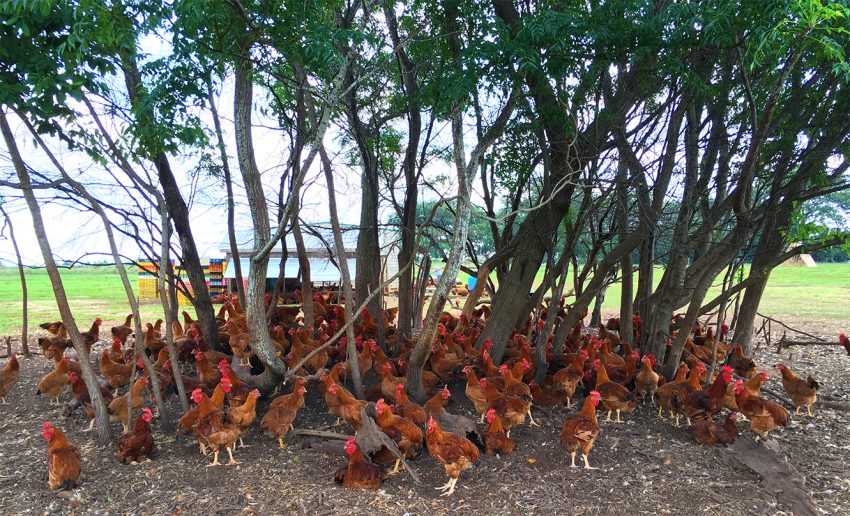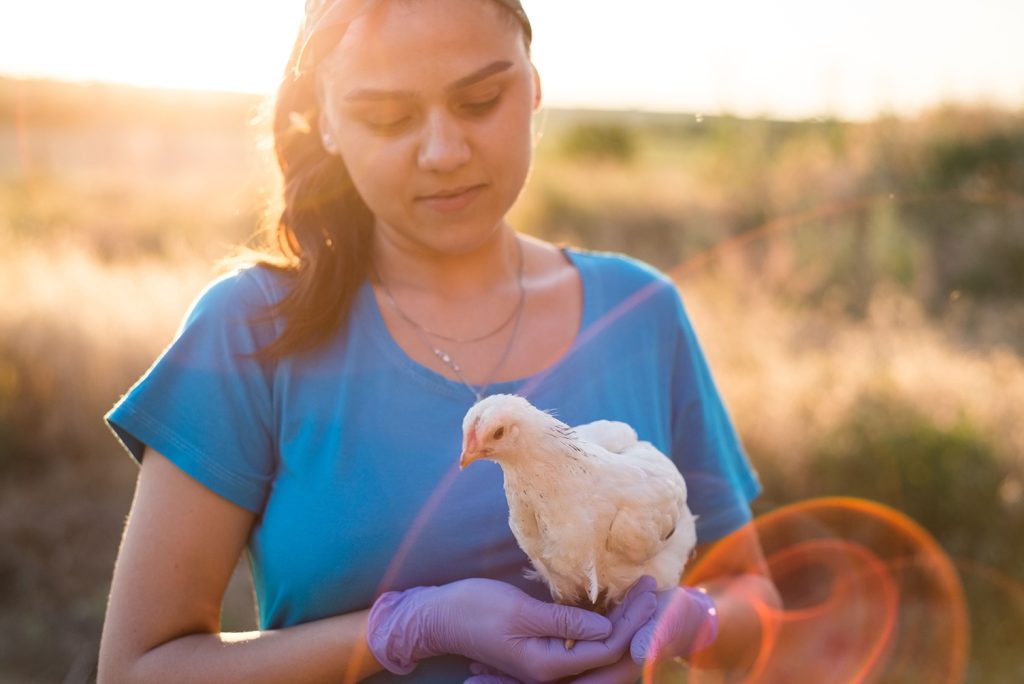From Chick to Chicken Nugget
We Americans love eating chicken. It’s our #1 choice for sandwich-filling, salad-topping, and appetite-ending protein. We eat more of it here in the U.S. than any other country in the world.
You’d think that chicken farmers, who are meeting all this demand with their lean white juicy supply, would be living large. And so you might be surprised to learn that 71% of chicken farmers whose sole income source is chicken farming live at or below the poverty line. To understand why, we need to take a hard look at the chicken industry: how it’s structured, how it functions, and who benefits from it.
First thing to know is that the poultry sector is extremely concentrated: big companies have been gobbling up small ones for decades, and then merging with other big ones to grow their power and profits. Poultry’s concentration ratio, or the market share controlled by the four largest firms in the industry (CR4), jumped from 54% to 60% in 2022 — and that was just from one big merger. For context, a low concentration ratio indicates a competitive industry, and any CR4 past 40% means that industry is wide open to price-gouging, abusive business dealings, and other anti-competitive practices.
Next to know is that those few corporations control the production process from top to bottom: hatcheries, feed, veterinarians, trucking, processing, and retail sales. Corporations retain ownership of the chickens for their entire lives, but pay farmers to provide the labor, facilities, and waste management necessary to raise them. This model is called “contract growing,” and it is how almost all chicken is produced in the U.S.
Anatomy of the Contract Growing System
First, some terms.
Integrators: Companies like Tyson or Cargill, the integrators, deliver young poultry, feed, and veterinary supplies to contract producers. After the animals are grown up and ready for processing, integrators pick them up. Integrators own the poultry and control their production at every stage, including meatpacking.
Contract Growers: You might have once called them a “farmer,” but once they sign an agreement with an integrator, they become a contract poultry grower. Growers essentially have three jobs: 1) landlord of a building, 2) labor to tend someone else’s poultry, and 3) manure manager. They must perform these three jobs according to the integrator’s strict specifications.
The relationship between the integrator and contract grower is defined by power imbalance. Integrators manage all meaningful decisions about how the operation will be done, making contract growers more like employees in their total lack of authority over their operations — except without the benefits of being an employee, like minimum wage and healthcare. If the integrator doesn’t deliver adequate feed, or shows up in the middle of the night with a delivery of feed, the grower must accept that. If the integrator calls for an upgrade to buildings or equipment, the grower must perform and pay for that upgrade promptly. Even if the integrator’s demands will negatively impact the birds’ health, the grower must carry them out.
Growers absolutely must stay in their integrator’s good graces. In other industries, someone who’s hired on contract is free to leave the arrangement if they feel they’re being taken for a ride. But in poultry, all that consolidation we mentioned means that a grower is often stuck with just one option for an integrator — something the integrators know and exploit to their advantage. If a grower speaks out against integrators’ practices, they can expect retaliation, or even a financially-fatal termination of their contract.
Not only are growers stuck with one integrator, they’re also often fully financially invested, and cannot just walk away. Growers must finance the buildings, the equipment, and the manure management themselves, and many take out loans against their house and land in order to meet the demands of the integrator. This makes them extremely vulnerable to disruptions anywhere in the food supply chain — and to the whims of the integrator. While growers are responsible for everything that depreciates in value, the integrator owns the only thing that increases in value: the animals. Insulated from the costs of infrastructure upkeep and market risks, the integrator is free to reap profits.
Integrators are armed with powerful tools — some of which were handed to corporations by the government — to help them maintain this unbalanced power dynamic.
The tournament system is a payment scheme used widely across the chicken production industry. Integrators pit their growers against each other to compete for the price they will be paid. The poultry growers who come out on top receive a bonus — but the company doesn’t pay it. Instead, it comes out of the paycheck of the lower performing growers. This scheme is a tool to control growers’ behavior: any grower who speaks out can be quietly and discreetly put out of business. It also fosters a truly abusive dynamic, in which a grower’s relationship with their integrator is the most important of all, above those with friends and neighbors.
The federal courts’ “competitive injury” interpretation of the Packers and Stockyards Act shields integrators from legal action. In order for a grower to take legal action against an abusive integrator, that grower would have to prove that competition was harmed across the entire industry. This is an impossible hurdle for a grower to overcome.
There are no rules against special treatment, or “undue preference.” Integrators can legally retaliate against unruly growers by giving preferential treatment to others, as long as they have a “legitimate business justification.” This 2020 change essentially enshrined the abusive practices that have led to excessive corporate profit.
Corporations Offer a Bad Deal to All Involved
Many growers were lured into their contracts with false promises of autonomy and wealth — clearly, this system does not work out for them.
But it’s not just the growers who suffer at the hands of Big Chicken. The industrial methods that corporations force their growers to use also wreak havoc on a region’s air and waterways, causing disastrous public health outcomes.
Delaware offers a case study for the community impacts of large-scale, industrial poultry production. Where once the small state was dotted with family farms and chickens raised primarily for eggs, the poultry industry has since grown rapidly, spawning bigger and bigger operations owned by fewer and fewer entities: In the past 20 years, Delaware has lost 45% of contract growers, but the pounds of chicken produced increased by 35%. If you can produce more meat with half as many growers — who’s winning? It’s not the community, and it’s definitely not the growers.
In this short video, Maria Payan of the Socially Responsible Agriculture Project describes the harms these consolidated industrial operations have inflicted on Delaware’s residents, and the vice-grip the integrators have over the community and its elected officials. “It is almost impossible to get meaningful legislation or enforcement,” she says. “It’s just too much power.”
Putting Power in the Hands of the People
It’s clear that the contract poultry growing system is a bad deal for farmers and the communities that surround large industrial operations. Our consolidated, industrial model is also not saving consumers any money: our research shows that any “short-term savings are pocketed by the corporations and distributed to the shareholders, while consumers see ‘sticky’ consumer prices that do not often come down once they have been raised.”
To rid our food system of the damaging influence of monopoly corporations, we must empower farmers while forcing the corporations to abide by more balanced rules. Back in 2010, there was an effort to implement the Farmer Fair Practices Rules, a set of reforms that would have shifted the balance of power into the hands of livestock and poultry producers and given them more tools to protect themselves against massive meatpackers and legal ground to stand on in the case of abuse. Unfortunately, these rules were defeated by corporate lobbyists.
The good news: we have another chance to defeat corporate influence in our food system! Our food policies determine the kind of food system we have, and so Farm Action is relentlessly pursuing a stronger Packers and Stockyards Act, a landmark law passed in 1921 that successfully leveled the economic playing field for farmers and ranchers. We’re also well underway with our fight for a Fair Farm Bill, which could transform our food system into one that pays farmers and workers a fair price for delivering nutritious, affordable food.

Written and designed by Dee Laninga; edited by Angela Huffman and Joe Maxwell; research by Sarah Carden, Angela Huffman, and Joe Maxwell.


